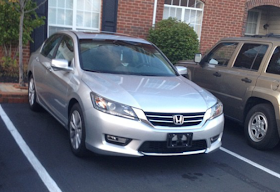Mazda has revealed the new 6 in its full glory at Moscow Motorshow. While the overall exterior styling has been unveiled last month (read HERE), this is the we can see the interior. The new Mazda6 is the second in line to fully adopt KODO design language and a host of Skyactiv chassis and drivetrain technology.
The front end adopts an entirely similar design concept with Mazda CX-5 with a prominent signature wing that runs from the radiator grille and into the headlight. The bulging fender is another Mazda trademarked since the Zoom-zoom days, and it here to stay. It basically blends the front fascia to the side profile via the sweeping fender that creates a kind of 3D look.
The side profile is characterized by the sweeping fender aforementioned and steeply raked glass house. However, the slit-like rakish line of the Takeri Concept is totally lost in the transition, the new 6 is merely scuplted, with none of the sharp distinctive character that can strengthened its presence. Perhaps it is the rear end that weaken the overall appearance. The downward pointing rear light, combinbed with soft-ish trunk lid and sculpted rear fascia prevents the mascular look. The rear light shape that work well on the hatchback end like the CX-5 does not really work here.
The interior theme again follow the same design concept as the CX-5 with the large central console housing the screen high-up. There is a decorative horizontal line extending through the centre console including across the aircond outlet duct. Soft touch panel is use effectively in the strategic area such as the upper panel of the dashboard and door trim.
While the overall theme is reminiscent of the CX-5, there is an added touch of premiumness compared to its smaller SUV sibling. For example, the climate control panel is different in design. The meter binnacle too is suitably upgraded with honeycomb pattern and spindle groove accompanied by the encircling metal ring.
Mazda6 is larger than the outgoing car by quite a margin. Overall length is 4,865mm, width 1,840mm and 1,450mm tall. Wheelbase is 2,830mm. In comparison, the old 6 measures 4,755mm,1,795mm, 1,440mm and 2,725mm in these dimensions respectively. As a results of this, there is 43mm more knee room at the back while the rear seat cushion has been increased by 20mm for added comfort. Boot space is 483L.
The new body structure is 50kg lighter that the car it replaced. Typical to Skyactiv epitome, chassis design is optimized with multi-load bearing structure, which when combined with the higher tensile steel giving out an overall weight reduction compared to the outgoing model. The new 6 is more aerodynamic too, with the drag coefficient of 0.26.
Mazda6 rides on McPhersons struts up front and Multi-link setup at the back. Wheel size is either 17 inch or 19 inch, depending on specification and wrapped by 225/55 R17 and 225/45 R19 respectively. Mazda is only revealing the powertrain that is relevant to the Russian market at the moment, namely the Skyactiv-G 2.0L and 2.5L, where both are in-line 4 cylinder with direct injection. The smaller displacement variety kicks out 150PS@6,000rpm and 210Nm@4,000rpm while the larger displacement punches out 192PS@5,700rpm and 256Nm@3,250rpm. Transmission choice is 6 speed automatic or 6 speed manual, and both gets i-Stop idling system. The 2.5L gets an additional features called i-ELOOP regenerative braking system which further enhanced fuel economy by supplying electrical power to the car system.
The European version of Mazda6 will debut later at Paris Motorshow, together with the stationwagon bodystyle. This debut will also mark the introduction of the diesel powertrain unit for Mazda6.
Some more photo of the new Mazda6 can be found after the jump.




















































